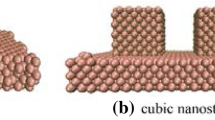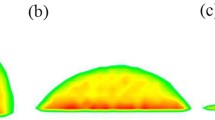Abstract
Understanding heat transfer characteristics of phase change and enhancing thermal energy transport in nanoscale are of great interest in both theoretical and practical applications. In the present study, we investigated the nanoscale vaporization and condensation by using molecular dynamics simulation. A cuboid system is modeled by placing hot and cold walls in the bottom and top ends and filling with working fluid between the two walls. By setting two different high temperatures for the hot wall, we showed the normal and explosive vaporizations and their impacts on thermal transport. For the cold wall, the cuboid nanostructures with fixed height, varied length, width ranging from 4 to 20 layers, and an interval of four layers are constructed to study the effects of condensation induced by different nanostructures. For vaporization, the results showed that higher temperature of the hot wall led to faster transport of the working fluid as a cluster moving from the hot wall to the cold wall. However, excessive temperature of the hot wall causes explosive boiling, which seems not good for the transport of heat due to the less phase change of working fluid. For condensation, the results indicate that nanostructure facilitates condensation, which could be affected not only by the increased surface area but also by the distances between surfaces of the nanostructures and the cold end. There is an optimal nanostructure scheme which maximizes the phase change rate of the entire system.













Similar content being viewed by others
Abbreviations
- H :
-
Height of the modeled system (Å)
- L :
-
Length of the modeled system (Å)
- r :
-
Distance between two atoms (Å)
- S :
-
Surface area
- R :
-
Surface area ratio
- W :
-
Width of the modeled system (Å)
- α :
-
Lattice constant (Å)
- σ :
-
Finite distance at which the interatomic potential is zero (Å)
- ε :
-
Depth of the L–J potential (eV)
- \( \emptyset \) :
-
Potential function (eV)
- Ar:
-
Argon
- Cu:
-
Copper
- n :
-
Cases of simulation
References
D.G. Cahill, W.K. Ford, K.E. Goodson, G.D. Mahan, A. Majumdar, H.J. Maris, R. Merlin, S.R. Phillpot, Nanoscale thermal transport. J. Appl. Phys. 93, 793–818 (2003)
D.G. Cahill, P.V. Braun, G. Chen, D.R. Clarke, S. Fan, K.E. Goodson, P. Keblinski, W.P. King, G.D. Mahan, A. Majumdar, H.J. Maris, S.R. Phillpot, E. Pop, L. Shi, Nanoscale thermal transport. II. 2003–2012. Appl. Phys. Rev. 1, 011305 (2014)
J. Tigner, M.M. Sedeh, T. Sharpe, A. Bufford, T. Floyd-Smith, Analysis of a platform for thermal management studies of microelectronics cooling methods. Appl. Therm. Eng. 60, 88–95 (2013)
R. Hopkins, A. Faghri, D. Khrustalev, Flat miniature heat pipes with micro capillary grooves. J. Heat Transf. 121, 102–109 (1999)
Y.J. Chen, P.Y. Wang, Z.H. Liu, Y.Y. Li, Heat transfer characteristics of a new type of copper wire-bonded flat heat pipe using nanofluids. Int. J. Heat Mass Transf. 67, 548–559 (2013)
F. Lefèvre, J.-B. Conrardy, M. Raynaud, J. Bonjour, Experimental investigations of flat plate heat pipes with screen meshes or grooves covered with screen meshes as capillary structure. Appl. Therm. Eng. 37, 95–102 (2012)
X. Lu, T.-C. Hua, Y. Wang, Thermal analysis of high power LED package with heat pipe heat sink. Microelectron. J. 42, 1257–1262 (2011)
C. Ding, G. Soni, P. Bozorgi, B.D. Piorek, C.D. Meinhart, N.C. MacDonald, A flat heat pipe architecture based on nanostructured titania. J. Microelectromech. Syst. 19, 878–884 (2010)
B.J. Alder, T.E. Wainwright, Studies in molecular dynamics. I. General method. J. Chem. Phys. 31, 459–466 (1959)
J. Zhang, F. Leroy, F. Müller-Plathe, Evaporation of nanodroplets on heated substrates: a molecular dynamics simulation study. Langmuir 29, 9770–9782 (2013)
A.K.M.M. Morshed, T.C. Paul, J.A. Khan, Effect of nanostructures on evaporation and explosive boiling of thin liquid films: a molecular dynamics study. Appl. Phys. A 105, 445–451 (2011)
H.R. Seyf, Y. Zhang, Molecular dynamics simulation of normal and explosive boiling on nanostructured surface. J. Heat Transf. 135, 121503 (2013)
H.R. Seyf, Y. Zhang, Effect of nanotextured array of conical features on explosive boiling over a flat substrate: a nonequilibrium molecular dynamics study. Int. J. Heat Mass Transf. 66, 613–624 (2013)
Y. Mao, Y. Zhang, Molecular dynamics simulation on rapid boiling of water on a hot copper plate. Appl. Therm. Eng. 62, 607–612 (2014)
H. Hu, Y. Sun, Effect of nanopatterns on Kapitza resistance at a water-gold interface during boiling: a molecular dynamics study. J. Appl. Phys. 112, 053508 (2012)
P. Yi, D. Poulikakos, J. Walther, G. Yadigaroglu, Molecular dynamics simulation of vaporization of an ultra-thin liquid argon layer on a surface. Int. J. Heat Mass Transf. 45, 2087–2100 (2002)
J. Yu, H. Wang, A molecular dynamics investigation on evaporation of thin liquid films. Int. J. Heat Mass Transf. 55, 1218–1225 (2012)
S.C. Maroo, J.N. Chung, Heat transfer characteristics and pressure variation in a nanoscale evaporating meniscus. Int. J. Heat Mass Transf. 53, 3335–3345 (2010)
C.S. Wang, J.S. Chen, J. Shiomi, S. Maruyama, A study on the thermal resistance over solid–liquid–vapor interfaces in a finite-space by a molecular dynamics method. Int. J. Therm. Sci. 46, 1203–1210 (2007)
G. Nagayama, M. Kawagoe, A. Tokunaga, T. Tsuruta, On the evaporation rate of ultra-thin liquid film at the nanostructured surface: a molecular dynamics study. Int. J. Therm. Sci. 49, 59–66 (2010)
S. Plimpton, Fast parallel algorithms for short-range molecular dynamics. J. Comput. Phys. 117, 1–42 (1995)
W. Humphrey, A. Dalke, K. Schulten, VMD: visual molecular dynamics. J. Mol. Graph. 14, 33–38 (1996)
H.J.C. Berendsen, J.P.M. Postma, W.F. van Gunsteren, A. DiNola, J.R. Haak, Molecular dynamics with coupling to an external bath. J. Chem. Phys. 81(8), 3684–3690 (1984)
M.S. Zabaloy, V.R. Vasquez, E.A. Macedo, Description of self-diffusion coefficients of gases, liquids and fluids at high pressure based on molecular simulation data. Fluid Phase Equilib. 242, 43–56 (2006)
H. Watanabe, N. Ito, C.K. Hu, Phase diagram and universality of the Lennard–Jones gas–liquid system. J. Chem. Phys. 136, 204102 (2012)
T. Jia, Y. Zhang, H.B. Ma, J.K. Chen, Investigation of the characteristics of heat current in a nanofluid based on molecular dynamics simulation. Appl. Phys. A 108, 537–544 (2012)
K. Nakanishi, K. Toukubo, Molecular dynamics studies of Lennard–Jones liquid mixtures. V. Local composition in several kinds of equimolar mixtures with different combining rule. J. Chem. Phys. 70, 5848–5850 (1979)
P.H. Hünenberger, Thermostat algorithms for molecular dynamics simulations. Adv. Polym. Sci. 173, 105–149 (2005)
S. Nosé, Constant-temperature molecular dynamics. J. Phys. Condens. Matter. 115, 115–119 (1990)
S. Nosé, A molecular dynamics method for simulations in the canonical ensemble. Mol. Phys. 100, 191–198 (2002)
C.Y. Ji, Y.Y. Yan, A molecular dynamics simulation of liquid–vapour–solid system near triple-phase contact line of flow boiling in a microchannel. Appl. Therm. Eng. 28, 195–202 (2008)
Acknowledgments
The financial support for this research project from the 111 Project No. B12034 and US National Science Foundation under Grant Number CBET-1404482 is gratefully acknowledged.
Author information
Authors and Affiliations
Corresponding author
Rights and permissions
About this article
Cite this article
Li, L., Ji, P. & Zhang, Y. Molecular dynamics simulation of condensation on nanostructured surface in a confined space. Appl. Phys. A 122, 496 (2016). https://doi.org/10.1007/s00339-016-0032-9
Received:
Accepted:
Published:
DOI: https://doi.org/10.1007/s00339-016-0032-9




